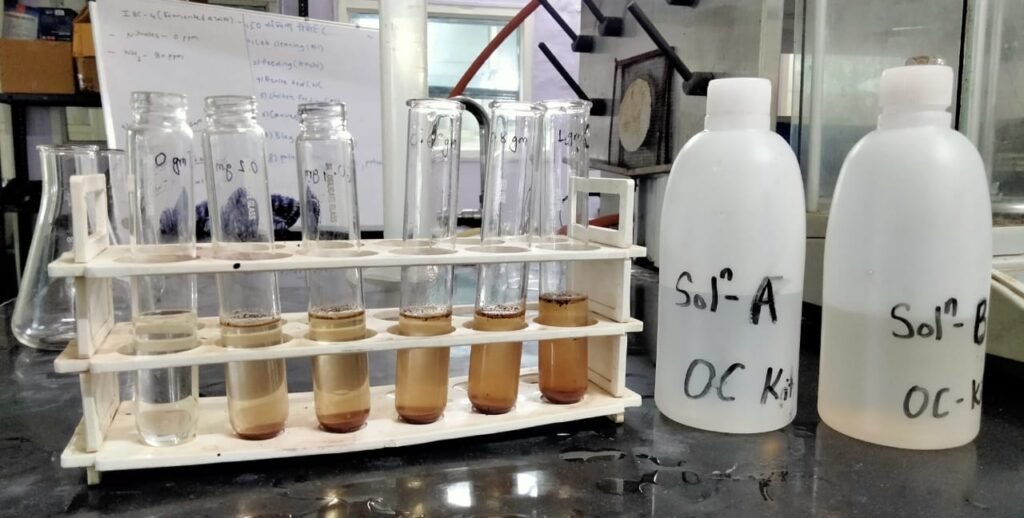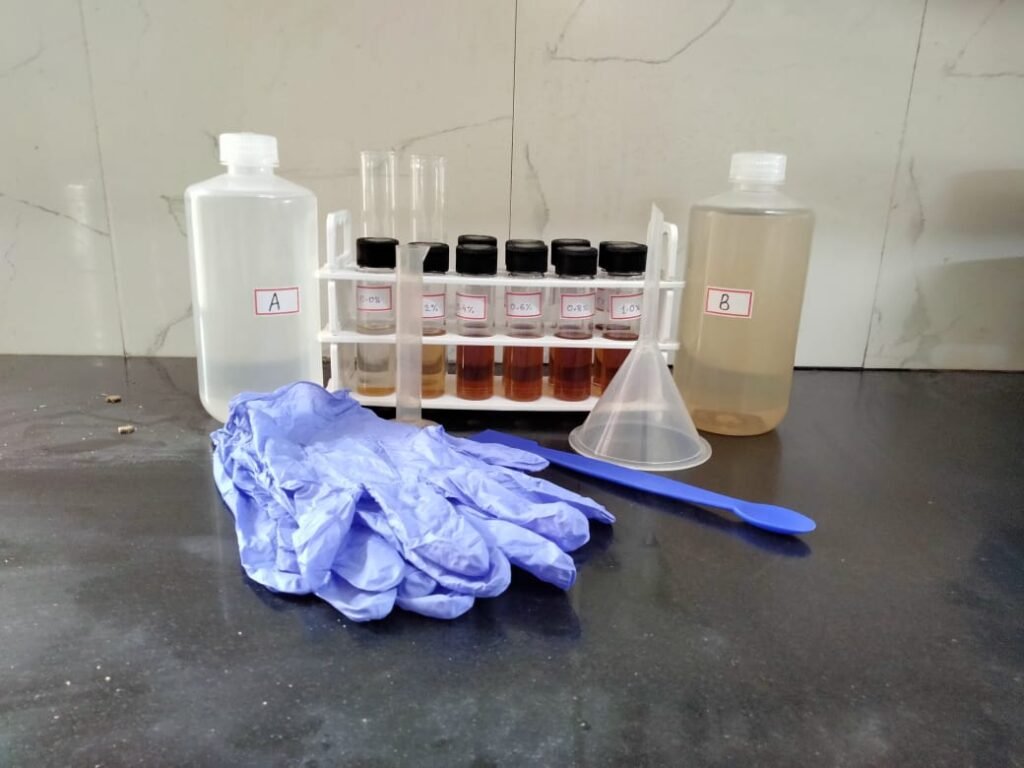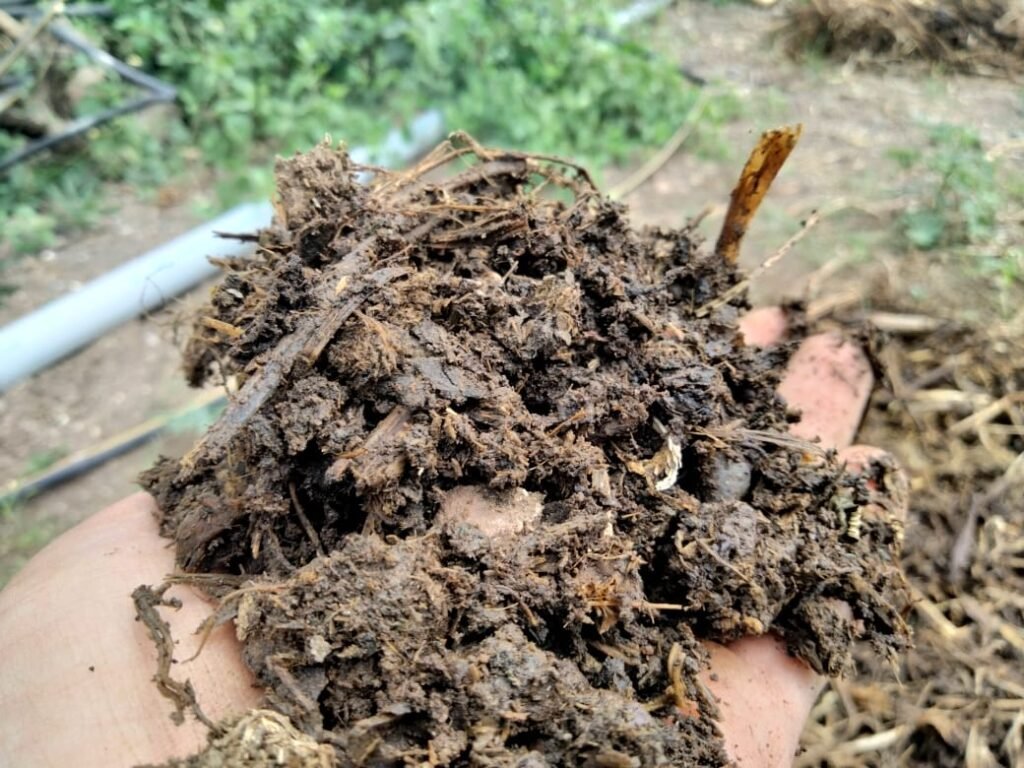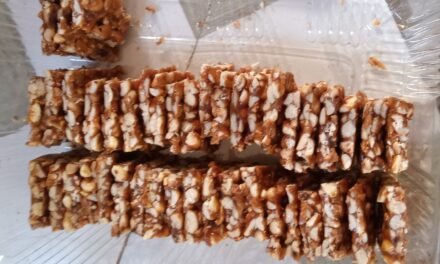OBJECTIVES:-
- To find out NUTRIENT CONTENT in bio-slurry.
- To find out MICROBIAL FLORA in bio-slurry after AERATION.
- Effect of bio-slurry on COMPOSTING BIOMASS.
- Methodology to treatment and use of bio-slurry in proper way in farm.
NEED OF PROJECT
In many developing countries, animal manure is anaerobically digested, to produce biogas, which is used for cooking, production electricity, as a bio-fuel in cars, etc. Besides biogas, anaerobic digestion produces a residue, the so-called digestate or bio-slurry, which contains most of the nutrients of the original manure, partially in a converted form and some get converted to the biogas (Methane) 50-70%,carbon dioxide-30-40%,and trace amount of other gases.
Numerous studies have been conducted on the comparative value of bio-slurry as a fertilizer and its comparative value to farmyard manure or cow dung manure. This bio-slurry can potentially be used as an organic fertilizer. It contains appreciable quantities of both micro-nutrients and also macro-nutrients when compared to other sources of organic nutrients . However, these studies do not provide a uniform message. The differences between the results of the studies can be due to several reasons, e.g. bio-slurry source, storage and handling, crop types, soil and climate conditions, or differences in methodologies to assess the value of bio-slurry as a fertilizer. To study all these points I’m working in Vigyan Ashram with collaboration of Cleanergy Tech Solution Pvt Ltd. Kisan Gas And Abhinav Farmers club.

NUTRIENT CONTENT
The anaerobic digestion of manure has very little to no effect on the amount of nutrients in the manure before and after digestion.
The value of bio-slurry as a fertilizer depends on:
• The nutrient contents, e.g. The amount of Organic carbon, nitrogen, phosphorus, potassium, calcium, magnesium, sulphur and micronutrients on a fresh or dry matter basis;
• The ratio between nutrients in the bio-slurry, e.g. C:N ratio, N:P-ratio and N:K-ratio; and
• The availability of the nutrients, which is determined by the compounds that contain the nutrients.
NITROGEN CONTENT (N)
Plants need nutrients for their growth and health. Nitrogen is one of the most important nutrients and is needed in large quantities to reach maximum yields, but it has to be in balance with other nutrients . Lack of N or excessive application can decrease yield and quality and can even damage crops. adequate amounts of N be present during periods of high plant N demand, whereas minimal amounts of N should be present during periods of little N uptake. N is generally added through chemical fertilisers. However, bio-slurry has been shown to be a promising alternative to fertilisers . Bio-slurry is well known for its plant nutrient availability, and as such can increase crop yields and soil nutrients while the carbon:nitrogen ratio can be low in sun-dried bio-slurry and high in fresh bio-slurry.
PHOSPHORUS CONTENT (P)
Phosphorus management can be difficult in organic production since approved sources are limited and the consequences of under- or over-fertilization can be significant. Since P is an essential element for plant growth involved in many critical plant metabolic functions, sustainable agricultural production depends on an adequate P supply.
POTASH CONTENT (K)
For most soils, the more crops depend on nonexchangeable K, the lower the yields. The K fixation capacity of the soil. Some soils have clay types that can fix large amounts of K from fertilizers or other sources. This reduces the availability of K to the crop. The amount of K in the subsoil and the density or consistency of subsoil layers.
Comparison between Biogas Slurry And Farmyard manure with respect to nutrient content (N,P,K).
| Kind of bio-slurry/Manure | Nitrogen% | Phosphorus% | Potash% | Author | |
| 1. | Digested Slurry | 1.5 to 2.0 | 1.0 | 1.0 | Khandewal et.al. 1986 |
| 2. | Digested Slurry | 1.03 | 0.82 | 1.07 | Gupta 1991 |
| 3. | Digested Slurry Sun-dried | 1.4 to 1.8 1.4 to 1.8 | 0.8 to 1.2 1.1 to 2.0 | 0.8 to1.0 0.8 to1.2 | Gupta 1991 |
| 4. | Digested Slurry | 3.6 | 1.8 | 3.6 | Wim J. Nes undated |
| 5. | Oven dried slurry Sun dried slurry | 1.6 to 3.7 0.97 to 1.0 | 1.6 to 2.2 0.24 to 0.28 | 0.8 to 3.6 0.84 to 0.97 | BSP/SNV,1995 Gupta 1991 |
| 6. | Slurry Compost | 0.57 to 2.23 | 0.72 to 2.11 | 0.0 to 5.1 | Average value of 100 slurry compost samples analysed by soil section NARC Khumaltar, 1996 |
| 7. | Ordinary Compost | 0.5 to 1.0 | 0.1 to 0.3 | 0.5 to 0.7 | Maskey. Dept. of Agriculture |
| 8. | Farm-yard Manure | 0.3 to 0.5 | 0.1 to 0.2 | 0.5 to 0.7 | Maskey. Dept. of Agriculture |
| 9. | Biogas effluent Biogas sludge | 0.03 to 0.08 0.8 to 1.5 | 0.02 to 0.06 0.4 to 0.6 | 0.05 to 0.1 0.6 to 1.2 | APRBTC, 1983 :155 |
| 10. | Fresh Slurry | 0.6 to 0.87 | 0.4 to 0.58 | 0.6 to 0.87 | ATC 1997 |
- Nitrogen content in bio-slurry is estimated by Kjeldahl method which involves a three-step approach to the quantification of nitrogen:digestion, distillation, and titration. In bio-slurry we get 1.2% nitrogen.
- Organic carbon in bio-slurry is estimated by Walkey black method.
- K is determined by using flame photometer and it is
| Nitrogen% | Phosphorus% | Potash% | Organic Carbon% | |
| Biogas Slurry | 1.2% | – | 0.89% | 28.25% |
ORGANIC CARBON (OC)
Soil organic carbon is a measureable component of soil organic matter. Organic matter makes up just 0.5-5% soil & has an important role in the physical, chemical and biological function of agricultural soils. Organic matter contributes to nutrient retention and turnover, soil structure, moisture retention and availability, degradation of pollutants, and carbon sequestration.
ORGANIC CARBON TESTING KIT
To find out the organic carbon content in soil,I am working on standerdization of OC testing kit by using walkley black method which is standard procedure to find out the organic carbon from soil.

Organic carbon kit 
Solid and liquid forms have different nutrient compositions. The nutrient composition of bio-slurry varies between studies, and it always depends on the original substrate, the type of digester and the anaerobic process. However, we can state here is that bio-slurry is not only rich in mineral and organic dry matter, but also in nutrients like N, P, K, Ca, Mg, Fe, Mn, organic matter, different amino acids and metals like copper and zinc. There seems to be a good match between soil N supply and plant N demand of liquid bio-slurry.
EFFECT OF BIO-SLURRY ON DECOMPOSITION OF BIOMASS
The development of ecological circular agriculture has been highly encouraged to recycle agricultural wastes, reduce mineral fertilizer input, and protect the environment. Biogas slurry , a by-product of biogas production generated from anaerobic digestion of animal waste and crop residues, is often considered a substitute to reduce mineral fertilizer input. Being a cheap source of organic matter and plant nutrients, its application may improve soil fertility and yield quality and quantity.
To study the decomposition pattern of bio-slurry on biomass, I had plotted 4 decomposition beds with different ratios of biomass, bio-slurry and consortium culture on 06/08/2021 as follows , Most biomass is of pumpkin straws and weeds.
- High biomass and low bio-slurry.
- Low biomass and high bio-slurry.
- high biomass , low bio-slurry with consortium culture.
- Low biomass , high bio-slurry with consortium culture.
1)Low biomass , high cow dung with consortium culture.
2) high biomass , low cow dung with consortium culture.
3)Low biomass and high bio-slurry.
4)High biomass and low bio-slurry.
There , I get one main problem that is to maintain the moisture level of that composting bed. we have to sprinkle water every after at least two days if we sprinkle some water every day then it will better to maintain moisture level. And one more problem was I did not weighted biomass and slurry properly. so in next week on 13/08/2021 I plotted 4 more beds for decomposition by taking proper weight of biomass and bio-slurry.
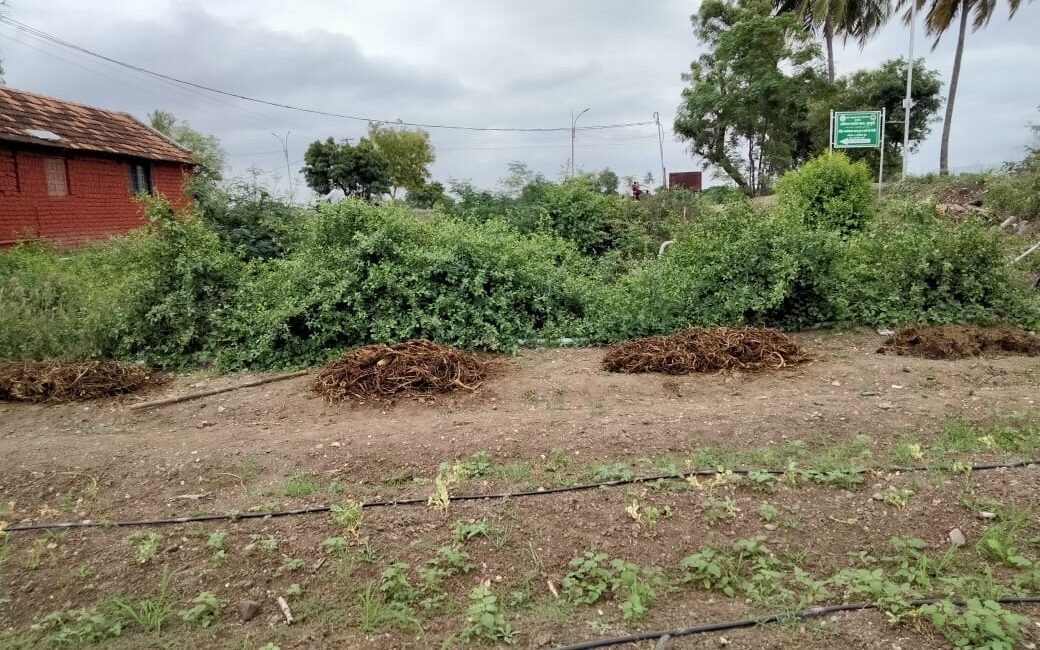
5) 20 Kg biomass +30 lit. bio-slurry + decomposition consortium
6)20 Kg biomass + 50 lit. bio-slurry + decomposition consortium
7) 20 Kg biomass + 30 lit. bio-slurry
8) 20 Kg biomass + 50 lit. bio-slurry
C:N Ratio of decomposition beds after 7 days
| Bed No. | Organic Carbon in % | Nitrogen in % | C:N ratio |
| 1 | 30.8 | 0.92 | 33.47 |
| 2 | 29.9 | 1.16 | 25.77 |
| 3 | 33.7 | 1.21 | 27.85 |
| 4 | 32.5 | 1.24 | 26.2 |
| 5 | 32.79 | 1.05 | 30.95 |
| 6 | 33.55 | 0.97 | 34.58 |
| 7 | 34.32 | 1.15 | 29.84 |
| 8 | 34.8 | 1.19 | 29.24 |
| 9 | – |
After 7 days of decomposition we collected samples from every bed to find C:N ratio and microbial flora and pH. after 7 days and 14 I had noted fungal growth in each bed by using potato dextrose agar. we observed that in first 7 days their was low fungal growth in each bed and after 14 days their were enormous growth of fungus.
pH measurement
sample was taken from five different locations or more by digging a hole from each bed.The compost sample was mixed with distilled water in the proportion 20gm compost to 20 ml D/W after that shaking it for 5 min. I had taken a reading of each composting bed.
pH was checked after every 7-10 days .
| Day 1 | Day 7 | Day 15 | Day 24 | |
| Bed-1 | 8.25 | 6.72 | 6.6 | 6.2 |
| Bed-2 | 7.9 | 7.2 | 6.6 | 6..34 |
| Bed-3 | 8.23 | 6.9 | 6.77 | 6.4 |
| Bed-4 | 8.13 | 7.2 | 6.8 | 6.5 |
| Bed-5 | 8.56 | 6.78 | 6.2 | 5.8 |
| Bed-6 | 8.2 | 6.9 | 6.52 | 6.1 |
| Bed-7 | 8.49 | 7.2 | 6.77 | 6.45 |
| Bed-8 | 8.12 | 6.7 | 6.54 | 6.21 |
C:N ratio and moisture content in bioslurry and biomass which I used :-
| Bio-slurry | Biomass | |
| C:N ratio | 28.25:1.2 ~23.54 | 39:0.8 ~ 48.75 |
| Moisture content | 96% | 8% |
Microbial Flora in decomposition beds
Bed no. 1-4 were tested for fungal flora after 15 days after plotting ,and bed no. 5-8 were tested after 7 days.
From the growth of fungus detected on PDA we can clearly observe that in Bed 1,2,5 and 6 fungal growth was maximum in which we used decomposition consortium because of that their was high rate of decomposition
And in bed no. 3,4,7 and 8 their was less growth of fungus so their was less decomposition rate in that bed
- Bacterial and fungal flora :–
| Bed No. | 1 | 2 | 3 | 4 | 5 | 6 | 7 | 8 |
| Bacterial flora (CFU) | – | – | – | – | 38 x 109 | 32 x 109 | 26 x 109 | 19 x 109 |
| Fungal flora | – | – | – | – | 19 x 109 | 15 x 109 | 9 x 109 | 8 x 109 |
| Bed No. | 1 | 2 | 3 | 4 | 5 | 6 | 7 | 8 |
| Bacterial flora (CFU) | 48x 109 | 37 x 109 | 32x 109 | 30 x 109 | 53x 109 | 45 x 109 | 39 x 109 | 42 x 109 |
| Fungal flora | 32 x 108 | 24 x 108 | 21x 108 | 18 x 108 | 42x 108 | 35x 108 | 30 x 108 | 23 x 108 |
| Bed No. | 1 | 2 | 3 | 4 | 5 | 6 | 7 | 8 |
| Bacterial flora (CFU) | 51x 109 | 40x 109 | 35x 109 | 32x 109 | 74x 109 | 53x 109 | 42x 109 | 48x 109 |
| Fungal flora | 37 x 108 | 28 x 108 | 23 x 108 | 21 x 108 | 56 x 108 | 41 x 108 | 32x 108 | 25 x 108 |
| Bed No. | 1 | 2 | 3 | 4 | 5 | 6 | 7 | 8 |
| Bacterial flora (CFU) | 51x 109 | 40x 109 | 35x 109 | 32x 109 | 113x 109 | 53x 109 | 42x 109 | 48x 109 |
| Fungal flora | 37 x 108 | 28 x 108 | 23 x 108 | 21 x 108 | 86 x 108 | 41 x 108 | 32x 108 | 25 x 108 |

After 15 days ,in bed no.5 we get visible difference
Chemical and Microbial analysis of good compost in bed no. 5
| Parameter | Value |
| Nitrogen | 1.34% |
| Potash | 190 ppm |
| Organic carbon | 14.85% |
| C:N ratio | 11.08 |
In bed no. 5 there was 113 x 10^9 bacterial count and 86 x 10^8 fungal count observed.
How to use bio-slurry for decomposition of agricultural biomass
From all above data we can use bio-slurry for decomposition of agricultural biomass as we used it in bed No. 5
Procedure to plot Decomposition beds
- Preparation or multiplication of consortium.
- Take a 200 lit. capacity water container and fill it with water .
- Add 2 Kg of jaggery, break it into small parts and dissolve in a water container.
- Add 1 lit. of consortium into the container and stir it well.
- Stir the solution twice a day in the morning and in the evening with a stick for 5 days.
- Plotting of composting bed.
- Collect Agricultural waste from farms at one place.(crop residues, weeds, leaf litter, sawdust,rice straw,wheat straw,sugarcane leaf,corn straw,etc.)
- Make a bed of 12 X 4 X 1 feet, And spray water to make it wet.
- Then add bio-slurry into it evenly,make sure the ratio of weight of waste and slurry is 2:3. If we have 200 kg of waste then add 300 lit bioslurry to it.
- Spread 8lit consortium for each 100kg waste and slurry .
- After every 3-4 days, spray water to maintain moisture in bed. And move the bed upside down.
- And after spreading water spread consortium as we did at first.
Microbial And fungal count of Filtered bio-slurry, and dried bio-slurry
To find out microbial flora of Normal Slurry, Filtered Slurry and Dried Slurry I had prepared NA and PDA
Bioslurry filtratate microbial analysis
| Bioslurry | Bioslurry filtrate | Dried bioslurry filtrate | |
| Microbial count | 132 x 10^9 | 86 x 10^9 | 72x 10^9 |
| Fungal count | 58×10^7 | 26 x 10^7 | 24×10^7 |


